In India, Bell Pepper is also called Simla Mirchi. Only non-spicy people in India are called Capsicum or Bell Pepper. Spicy varieties, on the other hand, are called chili. Bell Pepper is an important ingredient in multiple dishes in different foods. Therefore, their cultivation is not limited to any particular region. Almost all parts of the world have grown Bell Pepper for domestic use. India is one of the world’s largest Bell Pepper producers.

It not only produces Bell Pepper for its domestic use but also exports it to various other countries. The Bell Pepper producing states in India are Tamil Nadu, Karnataka, Himachal Pradesh, Uttar Pradesh, Madhya Pradesh, Kerala, Andhra Pradesh, Maharashtra, West Bengal, Gujarat, and Goa. Let’s check out the best season to grow Bell Pepper/Capsicum at home in India below.
Best season to grow Bell Pepper/Capsicum at home in India
Popular Bell Pepper varieties in India
Bomby (red) – This is an early maturing type. This type has a long and strong plant with good branches. It requires adequate shelter for fruit growth. It contains dark green fruits that turn red at maturity with an average weight of 130 to 150 grams. Its shelf life is long and can be ideal for long-distance transportation.
Orobelle (yellow)– It is mainly grown in cold climates. Fruits are about square in shape with a thick wall. Fruits turn yellow at maturity with an average weight of 150 grams. It is a disease-resistant type that can be grown in open fields and greenhouses.
Indra (green) – This type is a long and bushy shape. It has dark green leaves with dense leaves. This type of fruit is dark green with an average weight of 170 grams. Fruit growth begins after 50 to 55 days of sowing. It is ideal for long-distance transportation and has a long shelf life.
In case you missed it: Growing Capsicum In Greenhouse – Bell Pepper In Polyhouse
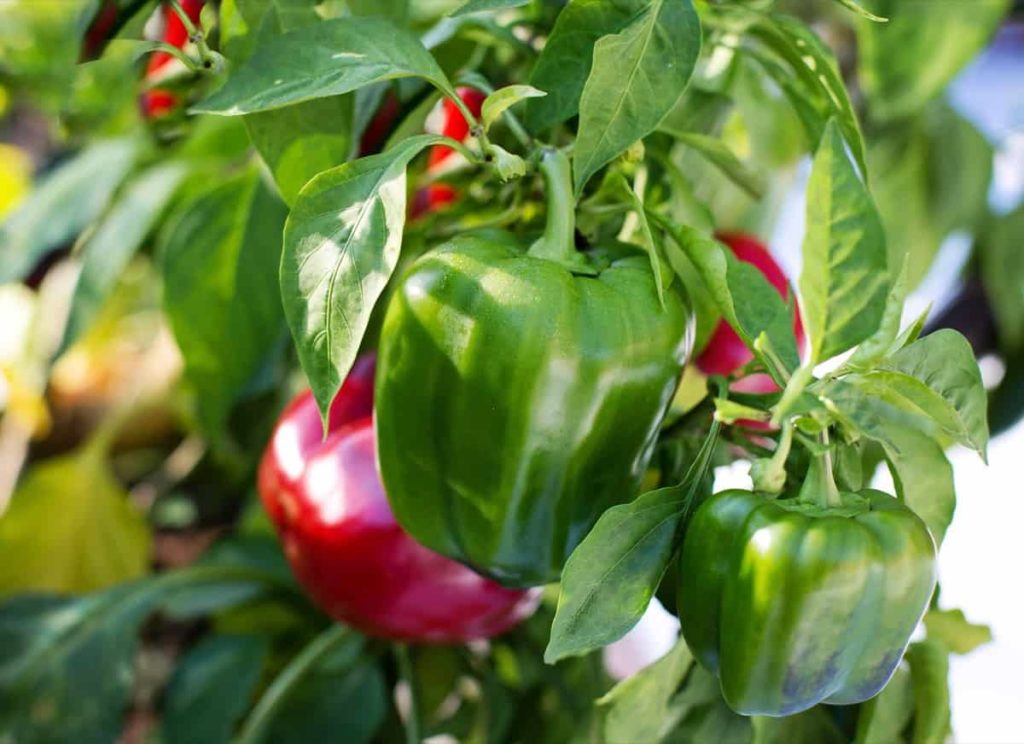
Climate requirement for growing Bell Pepper at home in India
The frost-free climate, with temperatures not going up, is 20 to 25°C on days and less than 20°C at night is the best for healthy Bell Pepper plants. Tropical and subtropical areas grow in winter in India like Karnataka, Tamil Nadu, Kerala, and Andhra Pradesh. While hilly areas like Himachal Pradesh, which experience a cold climate, grow it as a summer crop in the months from March to July.
Transplant a plant where it gets at least 3 to 5 hours of direct sun. Capsicum likes heat, but it can’t withstand too much heat. You may notice leaves shedding if the plant is exposed to extreme heat. Farmers in India grow it throughout the year, using various techniques such as greenhouse farming or indoor farming to meet the domestic and international demand for the crop.
Soil requirement for growing Bell Pepper at home in India
Grow Bell Pepper in a place with full sunshine and well-draining (but not wet) soil. The balance between sandy and loamy soil will ensure that the soil drains well and heats up quickly. Mix large amounts of organic matter in the soil, especially when working with heavy clay. Soil organic matter is an important component of soil; thus, the use of broken compost and rotten composted manure are effective ways to add organic matter to the soil.
Manures and Compost nutrients depend on several factors, including source, moisture content, handling, and storage. Compost and manures add nutrients but should be accompanied by other organic fertilizers such as nitrogen. Bell Pepper plants are not particularly sensitive to soil acidity; however, the best crops are obtained between pH 6.5 and 6.8. You should note that the plants may grow strongly due to excess nitrogen fertilizer, but fruit production is very low.
In case you missed it: Growing Capsicum Hydroponically (Bell Pepper)
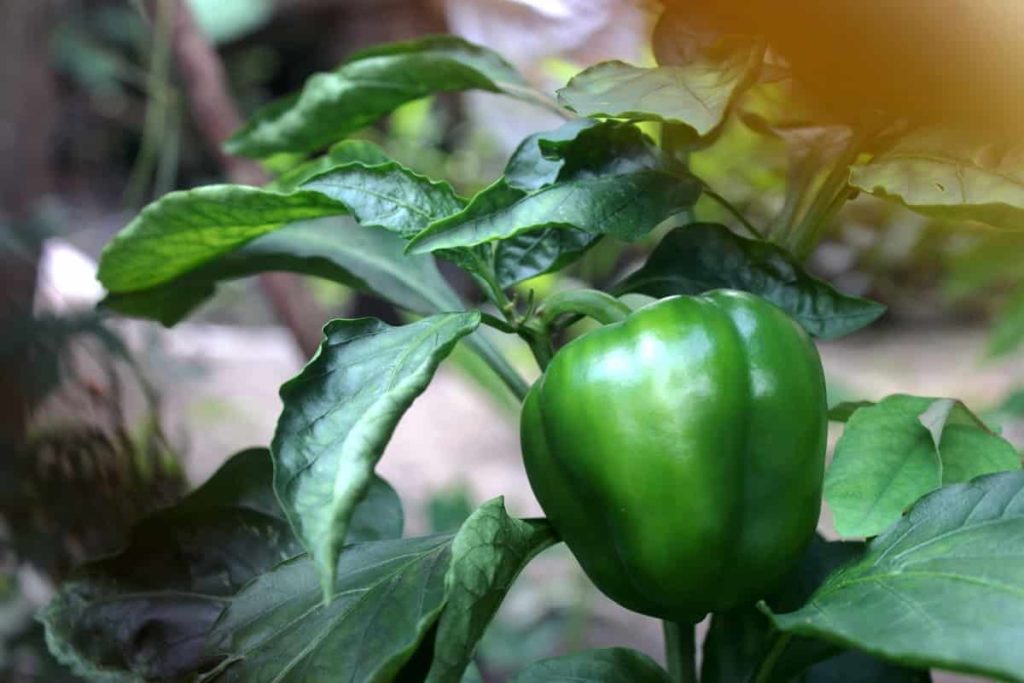
Water requirement for growing Bell Pepper at home in India
Capsicum does not require a lot of water. Still, whenever the upper soil feels dry, you should try to maintain steady moisture by watering its soil, which you’ll probably get every day, considering that it stays directly in sunlight for quite a couple of hours. So, ensure you’re not allowing a large portion of the soil to dry.
Regular water is required to keep the soil a little moist to grow Bell Peppers; the growing source should never dry completely. The best way is to water the at feet or around its base. Also, Bell Pepper plants in pots are constantly prone to overwater, so be careful not to sit in your plant’s water. In any case, avoid wetting the leaves as overhead watering can cause fungal infections.
Bell Pepper seed collection
The viable seed comes entirely from the ripe Bell Pepper, which has generally gone through the preferred eating stage of maturity. Pick the Bell Peppers when they reach their full color, and the skins start to wrinkle. Cut the Bell Pepper, remove the fruit’s seeds, and stir in a bowl. Seeds must be dried for a week or two to store well unless you plant them immediately.
Spread them on the same sheet on paper plates and let them dry completely in a hot, dark, and dry place. If you are not storing seeds, you can plant them in the pots immediately after collecting them.
Seed rate, spacing for growing Bell Pepper in Backyards
You should use 200 to 300 grams of seeds for one acre of land. Before you plant Bell Pepper outside, it must be certain that the possibility of frost has expired long ago. A frost will kill plants completely or stop Pepper growth, leaving you with bare plants. You should place Pepper plants in the soil at a distance of 18 to 24 inches. They will enjoy being planted near your Tomato plants. Before planting the ground, the soil should be well-drained and amended. Healthy Pepper plants should produce Bell Pepper at the end of summer.
In case you missed it: Capsicum Seed Germination, Time, Period (Bell Pepper)
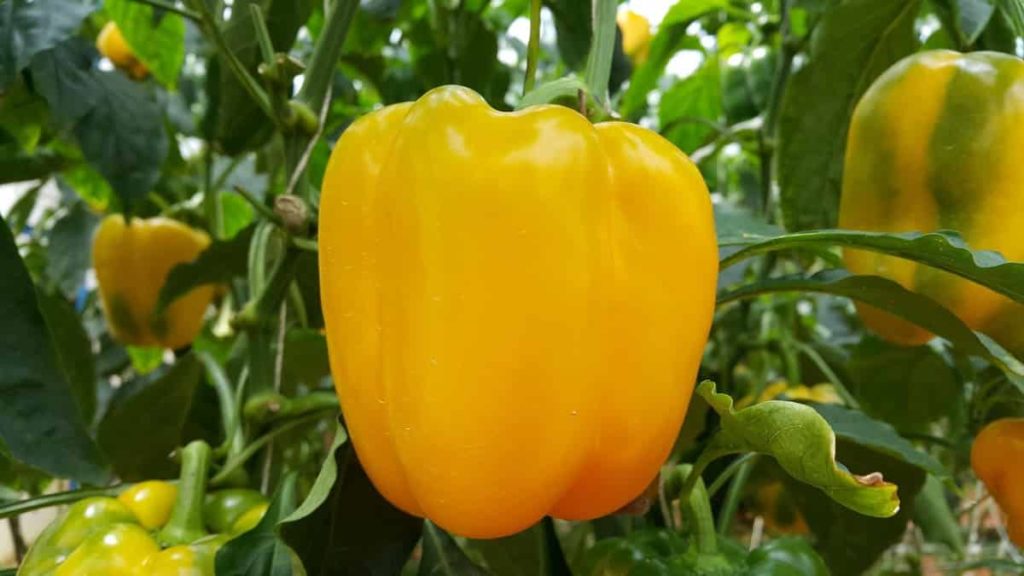
Bell Pepper seed treatment
To prevent seed-related diseases, soak the seeds in 2 grams of Thiram or Captan, Ceresan before sowing seeds.
Best season for germination of Bell Pepper seed in India
When the temperature is 20 to 30°C, March-April is the best season to sow Bell Pepper seeds in India. Take a flat tray with drainage holes, and fill it with a potting mix of garden soil (50%) and coco peat (50%). Now sprinkle seeds keeping some space from each other. You should cover these seeds with a thin layer of the same potting mix, then gently mist the soil with a water sprayer. Place this tray in a partial shade and mist it whenever the top is dry.
Make sure their place is well finished, and there is proper sunlight. Leave it now to settle until your seedlings are ready. Bell Peppers seeds take 5 to 7 days to grow; they are exposed to direct sunlight to boost growth once they grow. After 18 to 20 days, the seedlings will become quite large (10 to 12 centimeters in length) and are ready to transplant into a container or backyard.
Best season for growing Bell Pepper in pots
- The Spring season is the best sowing season in Northern India. You can start the seeds indoors during winter before transplanting them out during the coming spring season.
- The winter season is the best sowing season in South India. You can start seeding within the house, preferably for better growth rates.
You can put the pots in different locations (apartment balconies, terraces, and outdoors) for proper sunlight, so choose lightweight pots. Bell Pepper requires a pot at least 10 to 12 inches deep and wide with enough drainage holes. You can grow up to 2 to 3 plants (small varieties) in such a pot. Avoid using a black container if you grow Bell Pepper in tropical climates. The better potting mix can be a mixture of vermicompost, cocopeat, and sand. Take the pot and fill it with a potting mixture.
Transplanting Bell Pepper seedlings
Capsicum seeds will start growing in about two weeks. When your Bell Pepper plants are about 10 to 15 centimeters long, you can replant them from the tray to their last place. Make sure their new place gets a fair amount of sunlight and about 2 to 4 inches of space to grow. Act gently when removing the seedling to ensure you do not damage its roots. You can choose a large pot or the perfect place in your garden to grow your plant.
You should dig a hole in the soil and place the root ball; pack the soil around the base of the seedlings so your plant is strong and steady. Before you move your bell paper plant into the backyard, check that the temperature does not go below 21°C at night, as this can shock your young plants and contribute to their premature demise. The best way is to wait for the last frost danger to pass. Growing Bell Pepper on your balcony is easier than growing them in the ground.
In case you missed it: How To Grow Bell Peppers (Capsicum) In Backyard
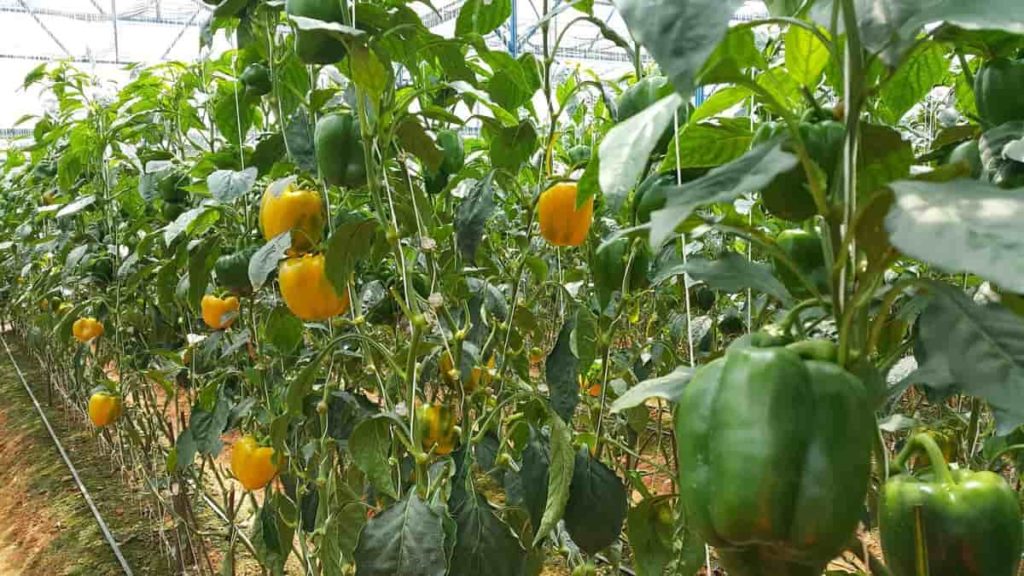
Pinching and pruning of Bell Pepper
When the plant is young, regularly pinch growing tips to make it bushy at an early stage. Pruning is not necessary but can be followed if required. Deadheading the flowers is important if your Pepper plant is blooming very quickly. It will guide the plant’s energy to grow and recover. If you want to accelerate the maturity of the Bell Pepper fruit already growing on the plant by pinching the emerging flowers, you can also stop the formation of new fruits.
Pests and diseases of Bell Pepper
Bell Pepper is easily affected by pests and diseases. Most Pests can either be picked up manually or sprayed away with detergent and water mixtures. If your plants start dying unexpectedly even after getting enough sunlight and water, there are chances that your plants are affected by the wilting disease. These diseases remain in the soil for a long time.
To prevent this, you should grow your Bell Pepper in large pots or areas where no Bell Pepper has been grown for a long time. The main pests that attack Bell Pepper are aphids and whiteflies. Bell Pepper plants are majorly affected by these small pests. These small pests usually suck sap from the tips of the plant shoots. These pests can be avoided by soap water can be sprayed on plants. Once the seedlings are strong, you can cover them with thin layers of neem oil that acts as an organic pesticide.
Fertilizer requirement for growing Bell Pepper at home in India
Like Tomatoes, Bell Pepper plants are heavy feeders, and you will need to fertilize the plant every 15 days or more. When fertilizing, remember the highly nitrogen-rich fertilizer that can boost leaf growth. Bell Pepper is quite slow to grow, unlike other plants, and needs to be fed with weekly or fortnightly doses of liquid fertilizer like a seaweed mix or compost tea, especially after it blooms.
You can also feed the Bell Pepper plants with tomato fertilizer. Also, feed the plant once a month with compost or manure tea. Epsom salt (using two teaspoons per gallon of water, you can also spray plants with this solution) improves health every month and increases the production of Tomatoes and Pepper plants, so you must apply it.
The best is adding compost or manure to the soil before planting seedlings. Also, when the plant starts to bloom for faster growth, you can fertilize the soil with compost tea or liquid fertilizers. Alternatively, you can also go for a 10-5-15 feed. Follow the instructions on the label.
In case you missed it: How to Prepare the Soil for Cabbage Plants: Best Soil Mix, pH, and Compost
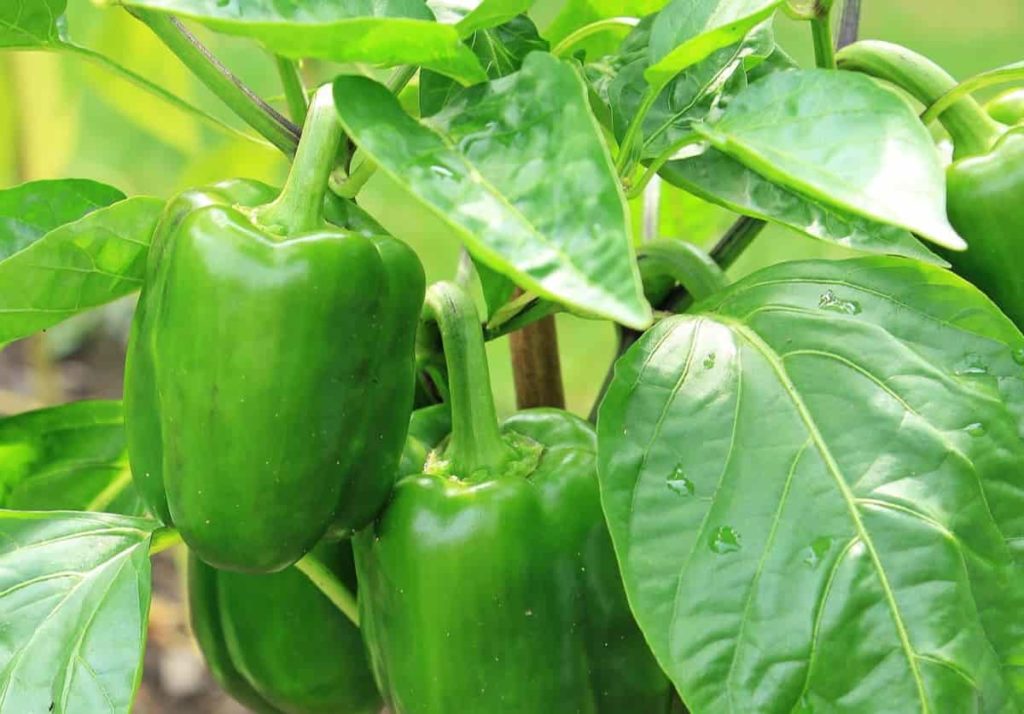
When and how to harvest Bell Pepper
Well-treated Bell Pepper plants begin to bear fruit within two months of planting. When the skin starts to look smooth and shiny Bell Pepper is the size of a tennis ball you can start harvesting your Bell Pepper. They will ripen if placed where sunlight comes in, even if you pluck them when they are not completely ripped off. When capsicums are ripped off, cut them.
Conclusion
You should know that Bell paper is quite sensitive to cold temperatures, so the good idea is to start seeds indoors before their growing season (spring or summer). Bell Peppers comes in all sizes and shapes, and you can find a type that meets your taste. From dessert to spicy, they offer a large range of flavors that will take your cooking to the next level.
The Bell Paper comes with challenges while growing and maintaining the plant, and you will feel incredibly proud when the first tiny Pepper makes its debut worldwide. This article will help you grow Bell Pepper in pots, balconies, terraces, and backyards. Grow delicious Bell Pepper to spice up your favorite dishes and taste buds.
- How to Grow Hibiscus from Flower
- Plantation Ideas for Home Decoration: A Beginners Guide
- Flower Garden Designs and Layouts for Beginners
- Planting and Spacing Techniques in Papaya: A Beginner’s Guide
- Growing Gold: Essential Techniques for Planting Pineapples
- How to Make Kalanchoe Plant Bushy: Home Remedies and Solutions
- 11 Reasons Why Your Gardenia is Not Blooming: Home Remedies and Solutions
- Eco Elegance: The Guide to Designing a Drought-Tolerant Landscape
- Gardening on a Slope: Strategies for Hillside Landscaping
- Nourish and Flourish: Top Organic Mulches for Thriving House Plants
- Everything You Want to Know about Indian Mogra Flower: Discover Uses and Growing
- Green Thumb Success: Expert Tips for Cultivating Greenhouse Pumpkins All Year Round
- Maximize Growth & Flavor: The Ultimate Guide to Companion Planting in Herb Gardens
- How to Control Rhododendron Problems Naturally: Home Remedies and Organic Ways to Fix Them
- Natural Magic: The Remarkable Benefits of Cinnamon for Plants
- Best Steps to Revive Dying Tulip with Natural and Organic Treatment
- 10 Reasons Why Your Angel Trumpet is Not Blooming: Remedies and Treatment
- How to Fix Periwinkle Leaf and Flower-Related Problems: Natural Remedies and Solutions
- How to Fix Zinnias Leaf and Flower Problems: Discover Natural and Home Remedies
- Organic Steps to Induce Lemon Tree Flowers: A Comprehensive Guide
- Bloom Booster: Crafting the Perfect Homemade Bougainvillea Fertilizer
- Optimizing Growth: A Guide to Applying NPK Fertilizer for Potted Plants
- 10 Best Homemade Fertilizers for Rubber Plant: DIY Recipes and Application Method
- How to Boost Female Pumpkin Flowers: Effective Steps for More Flowers and High Yields
- Transform Your Indoor Garden: Top Benefits of Pink Salt for Houseplants
- 10 Best Homemade Fertilizers for Peacock Plants (Calathea): Easy DIY Guide
- Unlock Blooms: 9 Reasons Why Your Potted Chrysanthemum is Not Blooming
- 8 Reasons Why Your Potted Hibiscus is Not Blooming: Fix it with Simple Solutions
- Unlock Blooms: 9 Key Reasons Your Potted Frangipani Won’t Flower
- 10 Reasons Why Is My Ice Plant Not Blooming: Remedies and Treatment
- 10 Reasons Why My Potted Hydrangea Not Blooming: Treatment and Remedies
- 10 Reasons Why is My Wisteria Not Blooming: Remedies and Treatment
- 10 Reasons Why is My Goldfish Plant Not Blooming: Remedies and Treatment
- Maximize Your Space: Ultimate Guide to Balcony Gardening with Grow Bags
- 10 Reasons Why Your Iris is Not Blooming: Remedies and Treatment
- 10 Reasons Why Your Anthurium Plant is Not Blooming: Treatment and Remedies